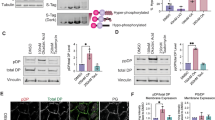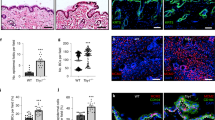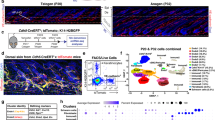Abstract
Integrins are heterodimeric transmembrane glyco-proteins which are engaged in a variety of cellular functions, such as adhesion, migration and differentiation1. The integrin α6β4 is expressed on squa-mous epithelia2, on subsets of endothelial cells3, immature thymocytes4 and on Schwann cells and fibroblasts in the peripheral nervous system5. In stratified epithelia, α6β4 is concentrated in specialised adhesion structures, called hemidesmosomes6,7, which are implicated in the stable attachment of the basal cells to the underlying basement membrane by connecting the intermediate filaments with the extracellular matrix8. The nature of the interactions between the various hemidesmosomal proteins, that lead to the formation of hemidesmosomes is poorly understood. To study the contribution of the integrin α6β4 in hemidesmosome formation and their anchoring properties, we inactivated the β4 gene in mice by targeted gene disruption. Homozygous β4 null mice died shortly after birth and displayed extensive detachment of the epidermis and other squamous epithelia. The dramatically reduced adhesive properties of the skin was accompanied by the absence of hemidesmosomes at the basal surface of keratinocytes. No evidence was found for impaired T-cell development, nor for defects in myelination in the peripheral nervous system.
This is a preview of subscription content, access via your institution
Access options
Subscribe to this journal
Receive 12 print issues and online access
$209.00 per year
only $17.42 per issue
Buy this article
- Purchase on Springer Link
- Instant access to full article PDF
Prices may be subject to local taxes which are calculated during checkout
Similar content being viewed by others

References
Hynes, R.O. Integrins: versatility, modulation, and signaling in cell adhesion. Cell 69, 11–25 (1992).
Kajiji, S., Tamura, R.N. & Quaranta, V. A novel integrin (αEβ4) from human epithelial cells suggests a fourth family of integrin adhesion receptors. EMBO J. 8, 673–680 (1989).
Kennel, S.J. et al. The β4 subunit of the integrin family is displayed on a restricted subset of endothelium in mice. J. Cell Sci. 103, 145–150 (1992).
Watt, S.M., Thomas, J.A., Edwards, A.J., Murdoch, S.J. & Horton, M.A. Adhesion receptors are differentially expressed on developing thymocytes and epithelium in human thymus. Exp. Hematol. 20, 1101–1111 (1992).
Niessen, C.M. et al. Expression of the integrin a6b4 in peripheral nerves: localization in Schwann and perineural cells and different variants of the β4subunit. J. Cell Sci. 107, 543–552 (1994).
Stepp, M.A., Spurr, M.S., Tisdale, A., Elwell, J. & Gipson, I.K. α6β4 integrin heterodimer is a component of hemidesmosomes. Proc. Natl. Acad. Sci. USA 87, 8970–8974 (1990).
Sonnenberg, A. et al. Integrin α6/β4 complex is located in hemidesmosomes, suggesting a major role in epidermal cell-basement membrane adhesion. J. Cell Biol. 113, 907–917 (1991).
Jones, J.C.R. et al. Hemidesmosomes: extracellular matrix/intermediate filament connectors. Exp. Cell Res. 213, 1–11 (1994).
Carter, W.G., Ryan, M.C. & Gahr, P.J. Epiligrin, a new cell adhesion ligand for integrin αjJI in epithelial basement membranes. Cell 65, 599–610 (1991).
Diaz, L.A. et al. Isolation of a human epidermal cDNA corresponding to the 180-kD autoantigen recognized by bullous pemphigoid and herpes gestationis sera. Immunolocalization of this protein to the hemidesmosome. J. Clin. Invest. 86, 1088–1094 (1990).
Hopkinson, S.B., Riddelle, K.S. & Jones, J.C.R. Cytoplasmic domain of the 180-kD bullous pemphigoid antigen, a hemidesmosomal component: molecular and cell biologic characterization. J. Invest. Dermatol. 99, 264–270 (1992).
Giudice, G.J., Squiquera, H.L., Elias, P.M. & Diaz, L.A. Identification of two collagen domains within the bullous pemphigoid autoantigen, BP180. J. Clin. Invest. 87, 734–738 (1991).
Vidal, F. et al. Integrin β4 mutations associated with junctional epidermolysis bullosa with pyloric atresia. Nature Genet. 10, 229–234 (1995).
Niessen, C.M. et al. Deficiency of the integrin β4 subunit in junctional epidermolysis bullosa with pyloric atresia: consequences for hemidesmosome formation and adhesion properties. J. Cell Sci. (in the press).
Guo, L. et al. Gene targeting of BPAG1: abnormalities in mechanical strength and cell migration in stratified epithelia and neurologic degeneration. Cell 81, 233–243 (1995).
Bonifas, J.M., Rothman, A.L. & Epstein, E.H. Epidermolysis bullosa simplex: evidence in two families for keratin gene abnormalities. Science 254, 1202–1205 (1991).
Chan, Y. et al. A human keratin 14 “knockout”: the absence of K14 leads to severe epidermolysis bullosa simplex and a function for an intermediate filament protein. Genes Dev. 8, 2574–2587 (1994).
Langhofer, M., Hopkinson, S.B. & Jones, J.C. The matrix secreted by 804G cells contains laminin-related components that participate inhemidesmosome assembly in vitro. J. Cell Sci. 753–764 (1993).
Sonnenberg, A. et al. Formation of hemidesmosomes in cells of a transformed murine mammary tumor cell line and mechanisms involved in adherence of these cells to laminin and kalinin. J. Cell Sci. 106, 1083–1102 (1993).
Mainiero, F. et al. Signal transduction by the α6β4 integrin: distinct b4 subunit sites mediate recruitment of Shc/Grb2 and association with the cytoskeleton of hemidesmosomes. EMBO J. 14, 4470–4481 (1995).
Kennel, S.J. et al. Sequence of a cDNA encoding the β4 subunit of murine integrin. Gene 130, 209–216 (1993).
Sambrook, J., Fritsch, E.F. & Maniatis, T. Molecular cloning; a laboratory manual. (Cold Spring Harbor Laboratory Press, Cold Spring Harbor, USA, 1989).
Gritz, L. & Davies, L. Plasmid-encoded hygromycin B resistance: the sequence of hygromycin B phosphotransferase gene and its expression in Escherichia coli and Saccharomyces cerevisiae . Gene 25, 179–188 (1983).
Adra, C.N., Boer, R.H. & McBurney, M.W. Cloning and expression of the mouse pgk-1 gene and the nucleotide sequence of its promoter. Gene 60, 65–74 (1987).
Te Riele, H., Robanus Maandag, E. & Berns, A. Highly efficient gene targeting in embryonic stem cells through homologous recombination with isogenic DMA constructs. Proc. Natl. Acad. Sci. USA 89, 5128–5132 (1992).
Robanus Maandag, E.C. et al. Developmental rescue of an embryonic lethal mutation in the retinoblastoma gene in chimeric mice. EMBO J. 13, 4260–4268 (1994).
Hooper, M., Hardy, K., Handyside, A., Hunter, S. & Monk, M. HPRT-deficient (Lesch-Nyhan) mouse embryos derived from germline colonization by cultured cells. Nature 326, 292–295 (1987).
Baudoin, C., Van der Flier, A., Borradori, L. & Sonnenberg, A. Genomic organization of the β1 gene: conservation of the β1D, but not of the β1B and β1C integrin splice variants. Cell Adh. Commun. (in the press).
Niessen, C.M. et al. The α6β4 integrin is a receptor for both laminin and kalinin. Exp. Cell Res. 211, 360–367 (1994).
Kennel, S.J. et al. Analysis of the tumor-associated antigen TSP180. Identity with α6β4 in the integrin superfamily. J. Biol. Chem. 264, 15515–15521 (1989).
Sonnenberg, A., Janssen, H., Hogervorst, F., Calafat, J. & Hilgers, J. A complex of platelet glycoproteins Ic and IIa identified by a rat monoclonal antibody. J. Biol. Chem. 262, 10376–10383 (1987).
Hieda, Y., Nishizawa, Y., Uematsu, J. & Owaribe, K. Identification of a new hemidesmosomal protein, HD1: a major, high molecular mass component of isolated hemidesmosomes. J. Cell Biol. 116, 1497–1506 (1992).
Hashimoto, T. et al. Further analyses of epitopes for human monoclonal anti-basement membrane zone antibodies produced by stable human hybridoma cell lines constructed with Epstein-Barr virus transformants. J. Invest. Dermatol. 100, 310–315 (1993).
DiPersio, C.M., Shah, S. & Hynes, R.O. α3Aβ1 integrin localizes to focal contacts in response to diverse extracellular matrix proteins. J. Cell Sci. 108, 2321–2336 (1995).
Rousselle, P., Lunstrum, G.P., Keene, D.R. & Burgeson, R.E. Kalinin: an epithelium-specific basement membrane adhesion molecule that is a component of anchoring filaments. J. Cell Biol. 114, 567–576 (1991).
Author information
Authors and Affiliations
Rights and permissions
About this article
Cite this article
van der Neut, R., Krimpenfort, P., Calafat, J. et al. Epithelial detachment due to absence of hemidesmosomes in integrin β4 null mice. Nat Genet 13, 366–369 (1996). https://doi.org/10.1038/ng0796-366
Received:
Accepted:
Issue Date:
DOI: https://doi.org/10.1038/ng0796-366
This article is cited by
-
Role of plectin and its interacting molecules in cancer
Medical Oncology (2023)
-
The impact of genetic manipulation of laminin and integrins at the blood–brain barrier
Fluids and Barriers of the CNS (2022)
-
Beclin 1 regulates recycling endosome and is required for skin development in mice
Communications Biology (2019)
-
Expanding and characterizing esophageal epithelial cells obtained from children with eosinophilic esophagitis
Pediatric Research (2018)
-
Granzyme B is elevated in autoimmune blistering diseases and cleaves key anchoring proteins of the dermal-epidermal junction
Scientific Reports (2018)


